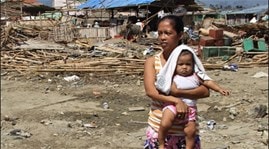Vietnam drops 7 places in maternal and child health index
However, over the past 15 years in Vietnam, maternal mortality has been halved and infant mortality has been reduced by a quarter.
 |
Save the Children's annual ranking of the best and worst places to be a mother, released recently, shows that Vietnam is now ranked 93rd in the 2014 Mothers' Index. Although down seven points from last year, Vietnam still ranks above regional countries such as the Philippines, Indonesia, Cambodia, Laos and Myanmar.
The Mothers Index is part of the organization's annual State of the World's Mothers report, which compares 178 countries to show which are succeeding and which are falling short in saving and improving the lives of mothers and children.
The report shows that maternal and child mortality in the world’s most challenged countries could be significantly reduced if efforts were made to improve services for mothers and children. In Viet Nam, over the past 15 years, maternal mortality has halved, infant mortality has fallen by a quarter, the average number of years of schooling has increased by 1.5 years and per capita income has almost quadrupled.
“Vietnam has made tremendous progress in maternal and child health over the past 15 years, a result of political will and a willingness to invest in the health system, including essential services for children,” said Gunnar Andersen, Country Director of Save the Children in Vietnam. “However, we should also be mindful of the fact that we have slipped down the rankings.”
This year’s State of the World’s Mothers report focuses on mothers in disaster risk situations, in order to better understand and support their needs in a timely and effective manner. In disaster risk situations, mothers often face many challenges in keeping their children safe and healthy, such as access to basic physical and economic health services, while also being vulnerable to poverty, malnutrition, sexual violence, unwanted pregnancies and unassisted childbirth.
“Vietnam is affected by devastating typhoons and floods every year. In recent years, natural disasters have become more severe due to climate change, causing damage to homes, crops, livestock and other assets such as agricultural machinery in severely affected areas. This damage in turn contributes to malnutrition, school dropouts and a decline in the use of voluntary health services,” said Gunnar Andersen.
Save the Children has been working in Vietnam for over 20 years, responding to all major natural disasters across the country, most recently typhoons Wutip and Nari. Save the Children provided cash assistance to families with children in severely affected areas to repair their homes, buy food and medicine, and send their children back to school after the storms.
To ensure the protection of mothers and children after natural disasters, Save the Children calls on countries and civil society organizations to: Ensure that all mothers and newborns living in crisis have access to quality health care; Support the strengthening of health system resilience and response to minimize the negative impacts of health crises; Develop appropriate prevention plans at national and local levels to meet the essential needs of mothers, children and newborns in emergencies; Ensure appropriate and coordinated financial resources to promptly meet the needs of mothers and children in emergencies./.
According to VOV.VN
